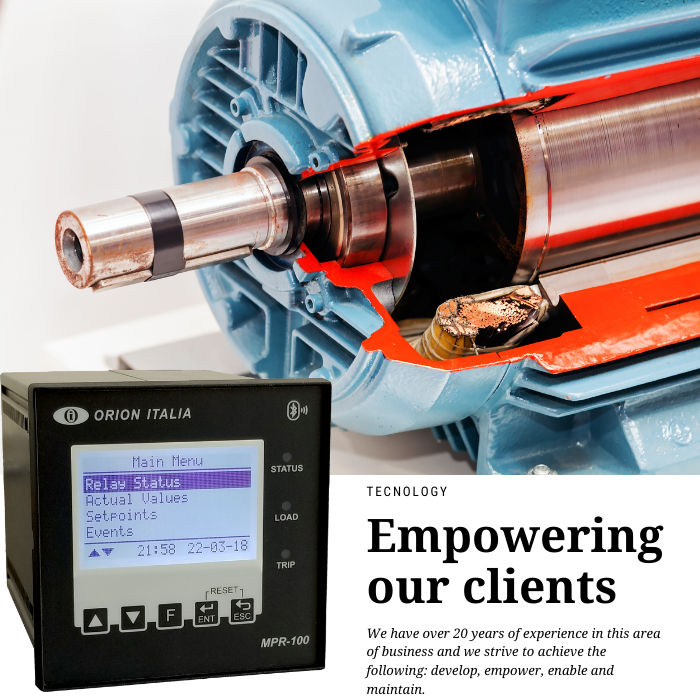Electric Motor
What is an electric motor?
An electric motor is a machine depending on the constitution of the motor: core with wound cable, without wound cable, single-phase, three-phase, with or without permanent magnets; the wattage depends on the gauge of the wire, the turns of the wire, and the electrical voltage applied
Orion Italia has hundreds of thousands of protection relay units installed around the world, click the link below to learn more about our digital device for motor protection:
General Characteristics
Performance: it is the quotient between the useful power they generate and the power absorbed. It is usually represented by the Greek letter η.
Low speed or nominal speed: it is the angular speed of the crankshaft, that is, the number of rotations per minute (rpm or RPM) at which it rotates. It is represented by the letter n.
Power: it is the work that the motor is capable of carrying out in the unit of time at a given speed of rotation. It is usually measured in horsepower (hp), with 1 hp equal to 736 watts.
Motor torque: it is the moment of rotation that acts on the motor shaft and determines its rotation. It is measured in kg * m (kilograms per meter) or what is the same newtons-meter (Nm), with 1 kgm equal to 9.81 Nm (9.81 kg * f * m). There are several types of torques, see for example starting torque, acceleration torque and nominal torque.
Development of Electric motors
Electric motors are rotating electrical machines that transform electrical energy into mechanical energy. Due to its many advantages, including its economy, cleanliness, comfort and operational safety, the electric motor has largely replaced other sources of energy, both in industry and in transport, mines, trade , or home.
Electric motors satisfy a wide range of service needs, from starting, accelerating, moving, or braking, to holding and stopping a load. These motors are manufactured in powers ranging from a small fraction of a horsepower to several thousand, and with a wide variety of speeds, which can be fixed, adjustable or variable.
An electric motor contains a much smaller number of mechanical parts than an internal combustion engine or a steam engine, making it less prone to failure. Electric motors are the most agile of all when it comes to power variation and can instantly go from idle to full operating position. They are smaller in size and systems can be developed to drive the wheels from a single engine, such as in automobiles.
The downside is that batteries are the only electricity storage systems, and they take up a lot of space. In addition, when they are used up, they need several hours to recharge before they can function again, whereas in the case of an internal combustion engine it is enough to just fill the fuel tank. This problem is solved, on the railroad, by laying a cable above the track, which is connected to the electric power generation plants. The locomotive obtains the current from the cable by means of a metallic piece called a skid. Thus, electricity storage systems are not necessary.
According to the nature of the transformed electric current, electric motors are classified into direct current motors, also called direct, alternating current motors, which, in turn, are grouped, according to their operating system, into induction motors, motors synchronous and collector motors. Both have all the elements common to electromagnetic rotating machines
DC Electric motors
The conversion of energy in an electric motor is due to the interaction between an electric current and a magnetic field. A magnetic field, which is formed between the two opposite poles of a magnet, is a region where a force is exerted on certain metals or on other magnetic fields. An electric motor takes advantage of this type of force to rotate a shaft, thus transforming electrical energy into mechanical movement.
The two basic components of every electric motor are the rotor and the stator. The rotor is a rotating part, a mobile electromagnet, with several lateral projections, each one carrying a winding through which the electric current passes. The stator, located around the rotor, is a fixed electromagnet, covered with an insulator. Like the rotor, it has a series of protrusions with electrical windings through which the current circulates.
When the electric current passes through the circuit, the armature begins to rotate and the rotation lasts until the loop reaches the vertical position. As the collector strips rotate with the loop, each half turn reverses the direction of the electric current. This means that the part of the loop that until then received the force upwards, now receives it downwards, and the other part the opposite. In this way the loop makes another half turn and the process is repeated while the armature rotates. The scheme described corresponds to a direct current motor, the simplest among electric motors, but which brings together the fundamental principles of this type of motor.
AC Electric Motors
Alternating current motors have a similar structure, with small variations in the construction of the windings and the rotor commutator. According to their operating system, they are classified into induction motors, synchronous motors and commutator motors.
Induction Motors
The induction motor does not need brushes or commutator. His armor is made of magnetizable metal plates. The alternating direction of circulation of the current in the turns of the stator generates a rotating magnetic field that drags the magnetizable metal plates, and makes them rotate. The induction motor is the most widely used alternating current motor, due to its strength and simplicity of construction, good performance and low cost, as well as the absence of a collector and the fact that its operating characteristics are well adapted to a constant velocity.
Synchronous Motors
Synchronous motors operate at a fixed synchronous speed proportional to the frequency of the applied alternating current. Its construction is similar to that of alternators When a synchronous motor operates at constant power and over-excited, the current absorbed by it presents, with respect to the applied voltage, an advance phase angle that increases with the excitation current This property is fa qUe has maintained the use of the synchronous motor in the industrial field, despite being the simplest induction motor, more economical and with comfortable starting, since with a synchronous motor, a low power factor in the installation can be compensated for by supplying the reactive current, in the same way as a capacitor connected to the network.










